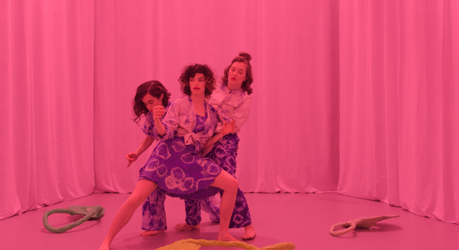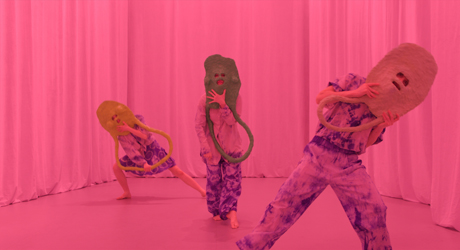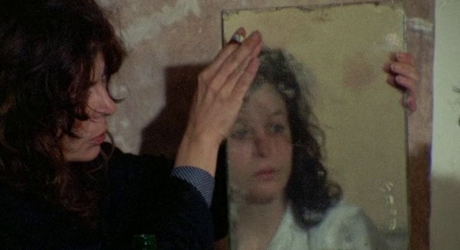
“How bad must it be to be pain / instead of pain adjacent?” So asks the chorus in Chloë Lum and Yannick Desranleau’s 19-minute, two-channel video opera What Do Stones Smell Like in the Forest? This half-interested, half-mocking query sets the stage for a unique and radically affirming exploration of chronic illness. Stones, first shown in the spring of 2018 at Concordia University’s Faculty of Fine Arts (FOFA) Gallery in Montreal, was developed over the course of two years and takes the form of a multimedia installation featuring two synced and looping videos, surrealist props, customized seating and live performances. Oblique in a manner reminiscent of certain medical diagnoses, Stones doesn’t present a conventional narrative so much as an impressionist portrait of illness experienced and expressed through an autofictional feminist perspective.
Seeing Stones for the first time, one is struck by its plethora of bold images. The video’s two channels are projected onto adjacent screens that host a dialogue, in opera form, between the protagonist (referred to simply as the “golem”) and the tie dye-clad three-woman chorus.In Jewish folklore, golems are beings made from mud or clay who are animated via mystical processes. This particular golem, performed by mezzo-soprano Marie-Annick Béliveau, appears exclusively in the right-hand channel, embodying the experience of the ill artist. The golem is enveloped by bulbous papier-mâché and plaster objects in shades of green and pinky-mauve—the latter hue reminiscent of lungs, intestines, and other internal organs—which appear to alternately support and encumber her. Beneath these almost cartoonish props, the golem’s ashy blond hair is teased high and her asymmetrical blue-and-orange makeup clashes with the shiny green backdrop. The contrast between the pathos of the golem’s performance and the playful, maximalist aesthetics of the piece invites the viewer to interpret Stones as a fantastic parable or fable, yet Lum and Desranleau resist supplying any moralizing conclusion. Instead, the viewer is left to consider the testimonies of the characters and the affective space conjured by sculptural props and costumes. Given the subject matter of the piece, Stones’ heavy reliance on visual tropes and symbolism can be read as a nod to the limitations of conventional language or narration when it comes to describing pain.
In response to the chorus’s question, “How bad must it be to be pain / instead of pain adjacent?” the golem replies: “I am always careful to not overstate pain, / to not overuse the word. / I know what doctors think of complaining women.”
On the left screen, next to the footage of the golem in her lair, is a projection of the avant-garde chorus, performed by Mary St-Amand Williamson, Karen Fennell and Maxine Segalowitz, who sing and dance while wielding large, mottled props that double as masks. The chorus’s stage is far more spacious than the golem’s and the three performers move nimbly across it. Early in the video they writhe, facing outward in a circle—an inverted version of MacBeth’s witches huddled over a cauldron, or a grotesque contortion of the Three Graces. As in Greek theatre, the chorus represents the social body and the audience; throughout the piece, they act as witnesses, interlocutors and antagonists to the golem. With staccato vocals punctuated by furtive physical gestures, the chorus sometimes delivers critical retorts to the golem’s expressions of pain and self-knowledge. At such moments, the chorus recalls Johanna Hedva’s theory that society renders the “sick woman” invisible by disavowing her political presence and social legitimacy.[i] At other times, however, the chorus echoes the golem, thereby producing an overall effect of ambiguous loyalty.

Viewers often must strain to make out the golem’s words—a fitting analogy for widespread social inattention to women’s illness. Visitors to the installation are able to follow along with the videos using printed transcripts of the libretto, which moves through a range of musical moods. Both the chorus and the golem regularly use an approach similar to Sprechstimme, an operatic mode wherein the voice oscillates between speech and singing, which emphasizes lyrical meaning. Stones culminates in an aria sung by the golem: during its crescendo—a disjointed melody, rife with accidentals and jarring leaps between low and high notes—the chorus lies down on the floor, masks resting beside their still bodies. Meanwhile, the golem pushes herself semi-upright using props that had earlier appeared to restrict her. She seems, at least in this moment, to have come to terms with the new physical and psychical realities imposed by illness. Throughout the opera, uneven melodies and sonic dissonance bring about moments of Brechtian distancing between the audience and the video performance. As a result, though viewers may empathize with the golem or the chorus, they are perpetually impelled to grapple with Stones’ conceptual stakes rather than experience a more straightforward catharsis via a happy or tragic finale.
The sick body, as presented in Stones’ angular sonic and visual landscapes, demands a revised and extended understanding of material alterity, hybridity, and change.
A short text introducing Stones when it travelled to Gallery TPW in Toronto described the piece as “a romance between body and object, a score for chorus and mezzo-soprano, an autofiction, a fantasy.”[ii] Throughout the opera, the viewer is prompted to reconsider relationships between bodies and (purportedly inanimate) matter. The mythological identity of the golem figures heavily in ensuing reflections. Not generally known to possess their own interiority, the dependency and malleability of the traditional golem stands in stark contrast to the depth of experience expressed by the protagonist of Lum and Desranleau’s musical melodrama. Stones’ golem is aware of how women can be ignored or mistrusted within both medical settings and the wider world. In response to the chorus’s question, “How bad must it be to be pain / instead of pain adjacent?” the golem replies: “I am always careful to not overstate pain, / to not overuse the word. / I know what doctors think of complaining women.” These lines compellingly reiterate the ways in which bodies can be rendered unknowable—and therein dismissible—objects via illness.

In Stones, the alterity of the human body is powerfully articulated in terms of interconnected physical and social experiences. Lines like “I keep dropping things” and “I must be passing as something / other than what I am” remind the viewer that hegemonic notions of physical capacity often dictate how bodies are interpreted. Lum and Desranleau explore the sick woman’s ability to manipulate inert matter—in other words, to produce work, specifically artwork—within this limited social framework. Midway through the opera, the golem laments: “How does one continue to birth a body of work / with a body that doesn’t, not labour or function? / If only I were a solid, inanimate thing.” This passage takes on a meta quality when one recalls that Stones is an autofiction, its creation inflected by Lum’s own experience of chronic illness. An allusion to Virginia Woolf’s suicide draws further attention to the complex relationships between health, mobility, and processes of making art. Late in the video, the chorus grows quiet as the golem raises herself up, her voice swelling:
The stones are heavy in my hand.
They smell like water and earth.
I slip one in my dress pocket to remember.
I’ve already forgotten it there.
These words echo a passage from Lum’s expanded text, What Do Stones Smell Like?, printed in the FOFA Gallery’s exhibition publication: “She filled her pockets with stones and ended up on the riverbed, her hair floating around like seaweed. She was 59, was Leonard relieved?” In light of Woolf’s selective advocacy[iii] for women’s creative labour and her concurrent mental health challenges, the golem’s stones can be understood as metaphoric weights simultaneously grounding and imperiling the sick woman artist.
Whether preparing herself for the doctor, a visit from friends, or to work in the studio, the sick woman inevitably anticipates scrutiny.
A tragic element of the opera lies in the golem’s self-consciousness about her precarious status. The chorus sings, “When the golem moves, / the clay pulls apart. / It doesn’t mend easily,” and other lines contrast the golem with the “sleeker, more beautiful, and functional [cyborg].” “The cyborg is sleek but smells of the one-dollar store,” Lum writes; “that is its contradiction.” The golem, on the other hand, is the “original cyborg, / a created body with a task at hand.” Here, Lum and Desranleau appear less intent on critiquing cyborg theory—a feminist conception of assemblage, reconstruction, and liberated fusions of nature and technology[iv]—than noting how the cyborg has, at times, been aestheticized in service of conventional femininity and hyper-functionalism. The sick body, as presented in Stones’ angular sonic and visual landscapes, demands a revised and extended understanding of material alterity, hybridity, and change.
An innate awareness of theatricality has been a through-line of Lum and Desranleau’s video and installation-based artworks. Their decision, in Stones, to use stable cameras, long shots and flat lighting presents illness as an experience that often necessitates a sustained and arduous performance by the sick individual. Whether preparing herself for the doctor, a visit from friends, or to work in the studio, the sick woman inevitably anticipates scrutiny. Stones’ high drama format—an opera with a golem as its diva—turns the traditional invisibility of illness on its head, placing the sick woman, and her analysis of society’s treatment, front and centre. Even the process behind the creation of Stones offers an alternative perspective on the challenges of making work when ill. Lum and Desranleau, who have collaborated for almost two decades, frequently team up with other artists and technicians to execute their large-scale multimedia projects. Developing a spectacular meta-vision and then generating specific directions, designs, choreography, music, and lyrics to share with collaborators can be seen as a means of adapting their creative process to accommodate the experience of illness. Importantly, however, the autofictional premise of Stones forswears presumption; rather than perform understanding or empathy for how individuals may navigate sickness and health, Stones’ audience is encouraged to reflect upon the possible horizons of our understanding and to consider who and what may be occluded.




